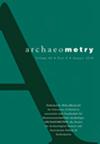计算机断层扫描在中石器时代便携式艺术品研究中的应用:结果、解释和期望——以波兰警方发现的饰有鹿角的鱼叉为例
IF 1.5
3区 地球科学
0 ARCHAEOLOGY
引用次数: 0
摘要
文章介绍了应用 X 射线计算机断层扫描技术记录和分析在波兰西北部警察局发现的中石器时代鱼叉上的装饰的情况。几何装饰被分为八个区域。根据断层扫描数据,提出了一种定量分析装饰的方法。对于在各个区域中选取的线条,确定了三个剖面,测量了装饰线条的宽度、深度和开口角度。对这些数据的分析,包括统计分析,显示出一定程度的差异,这取决于雕刻技术和制作装饰品的工具。本文章由计算机程序翻译,如有差异,请以英文原文为准。

Application of computed tomography to the study of Mesolithic portable art: Results, interpretations and expectations—The case of an ornamented roe deer antler harpoon from Police, north-west Poland
The article describes the application of X-ray computed tomography to the recording and analysis of ornamentation on the Mesolithic harpoon found at Police in north-west Poland. The geometric ornament was divided into eight areas. Based on the tomographic data, a method of quantitative analysis of ornamentation was proposed. For lines selected in individual areas, three profiles were determined for which the width, depth and opening angle of the ornament lines were measured. The analysis of these data, including statistical analyses, revealed a degree of variation, dependent on the engraving technique and the instrument used to make the ornament.
求助全文
通过发布文献求助,成功后即可免费获取论文全文。
去求助
来源期刊

Archaeometry
地学-地球科学综合
CiteScore
3.60
自引率
12.50%
发文量
105
审稿时长
6 months
期刊介绍:
Archaeometry is an international research journal covering the application of the physical and biological sciences to archaeology, anthropology and art history. Topics covered include dating methods, artifact studies, mathematical methods, remote sensing techniques, conservation science, environmental reconstruction, biological anthropology and archaeological theory. Papers are expected to have a clear archaeological, anthropological or art historical context, be of the highest scientific standards, and to present data of international relevance.
The journal is published on behalf of the Research Laboratory for Archaeology and the History of Art, Oxford University, in association with Gesellschaft für Naturwissenschaftliche Archäologie, ARCHAEOMETRIE, the Society for Archaeological Sciences (SAS), and Associazione Italian di Archeometria.
 求助内容:
求助内容: 应助结果提醒方式:
应助结果提醒方式:


